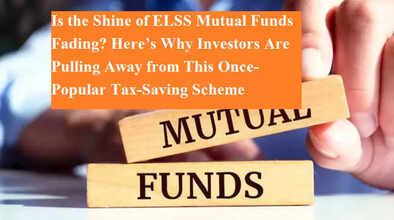Is the Shine of ELSS Mutual Funds Fading? Here’s Why Investors Are Pulling Away from This Once-Popular Tax-Saving Scheme

Equity Linked Savings Scheme (ELSS) mutual funds, once a top choice for tax-saving investments under Section 80C of the old tax regime, appear to be losing their appeal among Indian investors. The shift toward the new tax regime, which doesn’t offer deductions for ELSS investments, combined with better returns from other mutual fund categories, has led to a noticeable decline in ELSS’s popularity and inflow.
Sharp Decline in ELSS Inflows in FY26 Q1
Data from the April–June quarter of FY 2025–26 reveals a significant trend: ELSS mutual funds saw a net outflow of ₹1,616 crore—a clear signal that investors are withdrawing more money than they’re putting in. Over the last 12 months, ELSS witnessed a meager net inflow of ₹535 crore, an underwhelming figure when compared to other categories like flexi-cap funds, which attracted ₹56,309 crore in the same timeframe.
This shift reflects a broader investor sentiment: ELSS is no longer a tax-efficient nor performance-leading investment for most individuals, especially those transitioning to the new income tax regime introduced by the government.
The Role of the New Tax Regime in ELSS’s Decline
According to tax experts, the biggest reason behind this change is the rising adoption of the new simplified tax regime, which does not allow deductions under Section 80C, including ELSS investments. Gautam Nayak, a partner at CNK & Associates, explains, “The new regime has become significantly more attractive for taxpayers. Since ELSS no longer provides any tax relief under it, investors are avoiding it—particularly when it also comes with a three-year lock-in period.”
Once a Tax-Saver's Delight: ELSS Had the Shortest Lock-In
ELSS funds were previously favored for tax-saving because they offered the shortest lock-in period of just three years, compared to alternatives like PPF (15 years), NSC (5 years), and tax-saving FDs (5 years). The equity-based nature of ELSS also meant higher long-term returns, especially during bullish market cycles. Under the old tax regime, investors could save up to ₹1.5 lakh in taxes annually by investing in ELSS.
However, with the growing shift toward the new tax system—especially among salaried individuals—this key benefit is no longer relevant. And without the tax-saving incentive, the 3-year lock-in appears less attractive compared to more liquid investment options.
Weak Growth Signals Diminishing Interest
Another indicator of ELSS’s fading appeal is its slow growth rate. Over the past year, the total assets under ELSS have increased from ₹2.33 lakh crore to ₹2.49 lakh crore—a modest 6.9% growth. In comparison, other equity mutual fund categories have grown by nearly 22% during the same period.
This wide gap clearly shows that investor money is now flowing into more flexible and potentially higher-yielding funds, rather than into ELSS which now lacks both liquidity and tax advantages under the new rules.
Is This the End of the ELSS Era?
While it may be too early to declare the end of ELSS, the writing on the wall is clear. Unless future tax regulations reinstate deductions under Section 80C for new regime users or ELSS offers additional incentives, the scheme could soon be relegated to the sidelines of India's investment landscape.
For now, investors seem more inclined toward diversified funds with no lock-in periods, or options that align better with their financial goals and tax plans.
Takeaway for Investors
-
If you're still under the old tax regime, ELSS could remain a smart choice for combining equity growth with tax savings.
-
If you’ve switched to the new regime, ELSS no longer offers a tax incentive and may not be the most efficient option.
-
Always align your investments with your overall financial goals, risk appetite, and tax situation.
-
Before investing or redeeming ELSS units, consult a SEBI-registered financial advisor to make informed decisions.
Disclaimer: This article is for informational purposes only. It does not constitute investment advice. Always seek guidance from a certified financial planner before making any mutual fund investment decisions.

